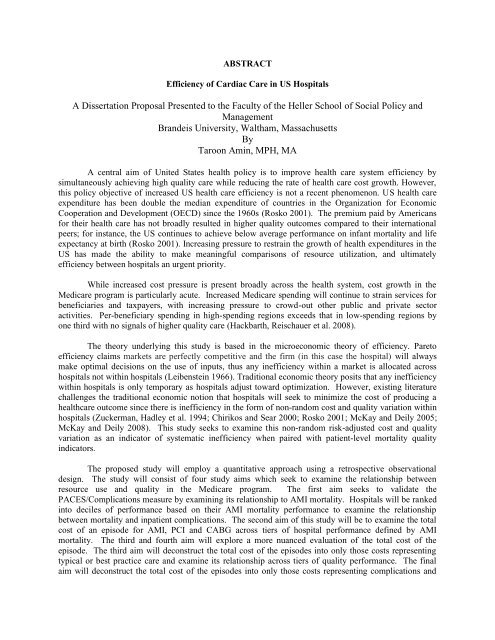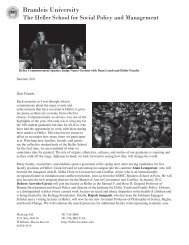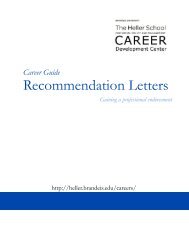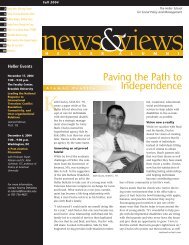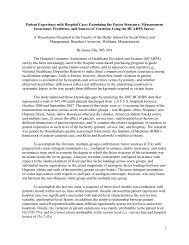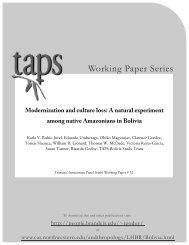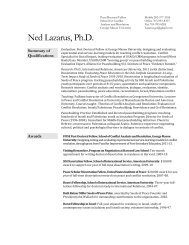A Dissertation Proposal Presented to the Faculty of the Heller ...
A Dissertation Proposal Presented to the Faculty of the Heller ...
A Dissertation Proposal Presented to the Faculty of the Heller ...
You also want an ePaper? Increase the reach of your titles
YUMPU automatically turns print PDFs into web optimized ePapers that Google loves.
ABSTRACT<br />
Efficiency <strong>of</strong> Cardiac Care in US Hospitals<br />
A <strong>Dissertation</strong> <strong>Proposal</strong> <strong>Presented</strong> <strong>to</strong> <strong>the</strong> <strong>Faculty</strong> <strong>of</strong> <strong>the</strong> <strong>Heller</strong> School <strong>of</strong> Social Policy and<br />
Management<br />
Brandeis University, Waltham, Massachusetts<br />
By<br />
Taroon Amin, MPH, MA<br />
A central aim <strong>of</strong> United States health policy is <strong>to</strong> improve health care system efficiency by<br />
simultaneously achieving high quality care while reducing <strong>the</strong> rate <strong>of</strong> health care cost growth. However,<br />
this policy objective <strong>of</strong> increased US health care efficiency is not a recent phenomenon. US health care<br />
expenditure has been double <strong>the</strong> median expenditure <strong>of</strong> countries in <strong>the</strong> Organization for Economic<br />
Cooperation and Development (OECD) since <strong>the</strong> 1960s (Rosko 2001). The premium paid by Americans<br />
for <strong>the</strong>ir health care has not broadly resulted in higher quality outcomes compared <strong>to</strong> <strong>the</strong>ir international<br />
peers; for instance, <strong>the</strong> US continues <strong>to</strong> achieve below average performance on infant mortality and life<br />
expectancy at birth (Rosko 2001). Increasing pressure <strong>to</strong> restrain <strong>the</strong> growth <strong>of</strong> health expenditures in <strong>the</strong><br />
US has made <strong>the</strong> ability <strong>to</strong> make meaningful comparisons <strong>of</strong> resource utilization, and ultimately<br />
efficiency between hospitals an urgent priority.<br />
While increased cost pressure is present broadly across <strong>the</strong> health system, cost growth in <strong>the</strong><br />
Medicare program is particularly acute. Increased Medicare spending will continue <strong>to</strong> strain services for<br />
beneficiaries and taxpayers, with increasing pressure <strong>to</strong> crowd-out o<strong>the</strong>r public and private sec<strong>to</strong>r<br />
activities. Per-beneficiary spending in high-spending regions exceeds that in low-spending regions by<br />
one third with no signals <strong>of</strong> higher quality care (Hackbarth, Reischauer et al. 2008).<br />
The <strong>the</strong>ory underlying this study is based in <strong>the</strong> microeconomic <strong>the</strong>ory <strong>of</strong> efficiency. Pare<strong>to</strong><br />
efficiency claims markets are perfectly competitive and <strong>the</strong> firm (in this case <strong>the</strong> hospital) will always<br />
make optimal decisions on <strong>the</strong> use <strong>of</strong> inputs, thus any inefficiency within a market is allocated across<br />
hospitals not within hospitals (Leibenstein 1966). Traditional economic <strong>the</strong>ory posits that any inefficiency<br />
within hospitals is only temporary as hospitals adjust <strong>to</strong>ward optimization. However, existing literature<br />
challenges <strong>the</strong> traditional economic notion that hospitals will seek <strong>to</strong> minimize <strong>the</strong> cost <strong>of</strong> producing a<br />
healthcare outcome since <strong>the</strong>re is inefficiency in <strong>the</strong> form <strong>of</strong> non-random cost and quality variation within<br />
hospitals (Zuckerman, Hadley et al. 1994; Chirikos and Sear 2000; Rosko 2001; McKay and Deily 2005;<br />
McKay and Deily 2008). This study seeks <strong>to</strong> examine this non-random risk-adjusted cost and quality<br />
variation as an indica<strong>to</strong>r <strong>of</strong> systematic inefficiency when paired with patient-level mortality quality<br />
indica<strong>to</strong>rs.<br />
The proposed study will employ a quantitative approach using a retrospective observational<br />
design. The study will consist <strong>of</strong> four study aims which seek <strong>to</strong> examine <strong>the</strong> relationship between<br />
resource use and quality in <strong>the</strong> Medicare program. The first aim seeks <strong>to</strong> validate <strong>the</strong><br />
PACES/Complications measure by examining its relationship <strong>to</strong> AMI mortality. Hospitals will be ranked<br />
in<strong>to</strong> deciles <strong>of</strong> performance based on <strong>the</strong>ir AMI mortality performance <strong>to</strong> examine <strong>the</strong> relationship<br />
between mortality and inpatient complications. The second aim <strong>of</strong> this study will be <strong>to</strong> examine <strong>the</strong> <strong>to</strong>tal<br />
cost <strong>of</strong> an episode for AMI, PCI and CABG across tiers <strong>of</strong> hospital performance defined by AMI<br />
mortality. The third and fourth aim will explore a more nuanced evaluation <strong>of</strong> <strong>the</strong> <strong>to</strong>tal cost <strong>of</strong> <strong>the</strong><br />
episode. The third aim will deconstruct <strong>the</strong> <strong>to</strong>tal cost <strong>of</strong> <strong>the</strong> episodes in<strong>to</strong> only those costs representing<br />
typical or best practice care and examine its relationship across tiers <strong>of</strong> quality performance. The final<br />
aim will deconstruct <strong>the</strong> <strong>to</strong>tal cost <strong>of</strong> <strong>the</strong> episodes in<strong>to</strong> only those costs representing complications and
examine its relationship across tiers <strong>of</strong> quality performance. This dissertation will use <strong>the</strong> Patient-<br />
Centered Episode System (PACES) methodology recently developed for <strong>the</strong> Medicare program <strong>to</strong> define<br />
episodes <strong>of</strong> cardiac care.<br />
This study will generate new knowledge on <strong>the</strong> relationship between resource use and quality for<br />
cardiac care in US hospitals. It will provide insight in<strong>to</strong> how policy can be developed <strong>to</strong> improve quality<br />
while reducing overall costs for cardiac services. This study posits that a trade-<strong>of</strong>f between cost<br />
minimization and quality maximization exists in health care markets, however this trade-<strong>of</strong>f may not be<br />
apparent at all levels <strong>of</strong> cost and quality. At <strong>the</strong> lowest levels <strong>of</strong> quality, investments in quality<br />
improvement may actually reduce overall costs. This analysis will inform value-based purchasing<br />
program development in <strong>the</strong> private and public sec<strong>to</strong>r.<br />
<strong>Dissertation</strong> Committee:<br />
Chris<strong>to</strong>pher Tompkins, PhD, Chair, Brandeis University<br />
Jennifer Perl<strong>of</strong>f, PhD, Brandeis University<br />
John Chapman, PhD, Brandeis University<br />
Helen Burstin, MD, MPH, School <strong>of</strong> Medicine and Public Health, The George Washing<strong>to</strong>n<br />
University School <strong>of</strong> Medicine & Senior Vice President, National Quality Forum (NQF)<br />
<strong>Proposal</strong> Hearing:<br />
Wednesday, April 25, 2012 at 1:00pm – 3:00pm.<br />
<strong>Heller</strong> School<br />
Room G55


